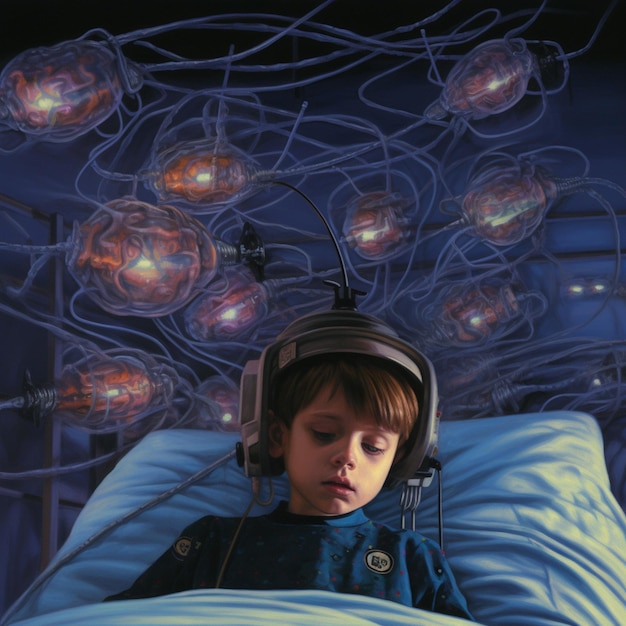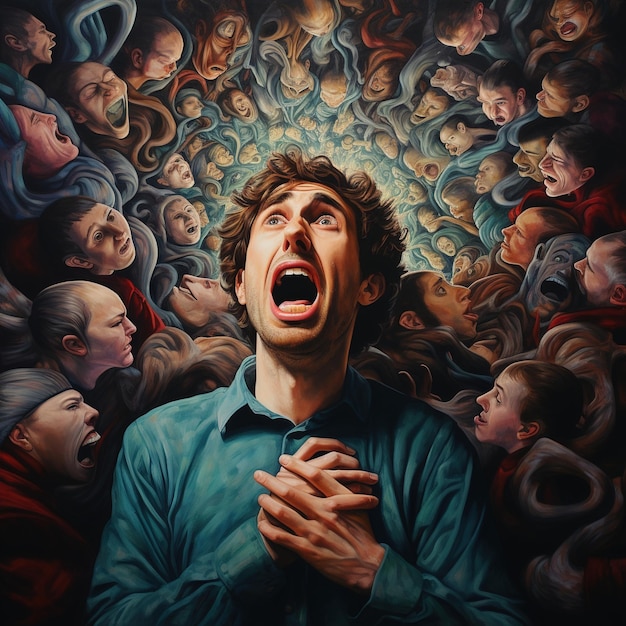Decoding Darkness: Unraveling the Mysteries of Depression and Anxiety
Quick Read
Decoding Darkness: Unraveling the Mysteries of Depression and Anxiety
Depression and anxiety are two mental health disorders that affect millions of people worldwide. These conditions can robbed individuals of their joy and zest for life, leading to a debilitating cycle of negative thoughts, emotions, and behaviors. Let’s delve deeper into these disorders and decipher the mysteries that surround them.
Anxiety: The Uninvited Guest
Anxiety, often referred to as the “restless mind,” is a pervasive fear or apprehension about the future. It can manifest in various forms, such as social anxiety, panic disorder, generalized anxiety disorder, and phobias. Anxiety can cause a range of physical symptoms, including increased heart rate, sweating, trembling, and shortness of breath, which can be both alarming and disabling.
Symptoms of Anxiety Disorders
Some common symptoms of anxiety disorders include:
- Feeling restless, wound-up, or on-edge
- Fatigue
- Difficulty concentrating
- Irritability
- Avoiding situations that trigger fear or anxiety
- Physical symptoms, such as heart palpitations and shortness of breath
Depression: The Dark Night of the Soul
Depression, also known as major depressive disorder, is a persistent feeling of sadness or loss of interest in activities. It can affect one’s appetite, energy levels, sleep patterns, and overall outlook on life. Depression can be all-consuming, making even the simplest tasks seem insurmountable.
Symptoms of Depression
Some common symptoms of depression include:
- Feeling sad, hopeless, or empty most of the time
- Loss of interest in activities once enjoyed
- Difficulty concentrating, remembering details, or making decisions
- Fatigue and decreased energy levels
- Feeling worthless or guilty
- Thoughts of death or suicide
Causes and Treatment
Both anxiety and depression can be caused by a variety of factors, including genetics, brain chemistry, lifestyle, and environmental factors. While there is no one-size-fits-all approach to treatment, effective interventions include medication, therapy, and lifestyle changes.
Treatment Options for Anxiety and Depression
Some treatment options include:
- Medication, such as antidepressants and anti-anxiety medications
- Psychotherapy, including cognitive-behavioral therapy (CBT) and interpersonal therapy (IPT)
- Lifestyle changes, such as regular exercise, a healthy diet, adequate sleep, and stress management techniques
Conclusion: A Beacon of Hope in the Darkness
While depression and anxiety can be incredibly challenging to live with, there is hope. By increasing awareness, understanding the causes, and seeking effective treatment options, we can help ourselves and others find relief from these debilitating conditions.
If you or someone you know is struggling with depression or anxiety, reach out to a mental health professional for help. You are not alone.

Understanding Depression and Anxiety: A Comprehensive Guide
Depression and anxiety are two of the most common mental health disorders worldwide. According to the World Health Organization (WHO), approximately 300 million people of all ages suffer from depression, and over 264 million experience anxiety disorders (link, link). These conditions can significantly impact individuals’ lives, causing emotional and physical distress. They can also negatively affect families and society as a whole, leading to decreased productivity, increased healthcare costs, and strained relationships.
Personal Stories: The Human Side of Depression and Anxiety
I remember the day I was diagnosed with major depressive disorder and generalized anxiety disorder. The words that came out of my doctor’s mouth felt like a ton of bricks falling on me. I was 28 years old, successful in my career, and had a loving family. But behind closed doors, I was battling constant sadness, fear, and self-doubt. I couldn’t understand why I felt this way when I had so much to be grateful for. It took me a long time to accept my diagnosis and learn that mental illness is not a sign of weakness but rather an illness like any other.
Purpose of This Book: Providing a Comprehensive Understanding
This book aims to provide you with a comprehensive understanding of depression and anxiety. We will explore the causes, symptoms, diagnosis, treatments, and coping strategies for these conditions. Our goal is to help you or a loved one navigate the complex world of mental health. We believe that knowledge is power, and understanding these disorders can be the first step towards recovery.
Causes: What Leads to Depression and Anxiety?
In the following chapters, we will delve into the potential causes of depression and anxiety. From genetics and brain chemistry to environmental factors and life events, we will explore the various influences that contribute to these conditions.
Symptoms: Recognizing the Signs
An essential aspect of understanding depression and anxiety is recognizing their symptoms. In this section, we will discuss the common signs and symptoms of these disorders, helping you identify if you or someone you know may be struggling.
Diagnosis: Finding Answers
Once you or a loved one has been identified as having depression or anxiety, the next step is finding an accurate diagnosis. In this chapter, we will discuss how mental health professionals diagnose these conditions and what to expect from the diagnostic process.
Treatments: Healing and Recovery
Fortunately, there are various treatments available for depression and anxiety. From therapy and medication to lifestyle changes and holistic approaches, we will explore the different options and their effectiveness in helping individuals heal and recover.
Coping Strategies: Thriving Amidst Adversity
Finally, we will discuss coping strategies for living with depression and anxiety. From mindfulness practices to building a support network, we will provide you with practical tools to help manage these conditions and improve your overall well-being.

Understanding Depression
Definition, symptoms, and diagnostic criteria
Depression is a mental health disorder characterized by persistent feelings of sadness, hopelessness, and loss of interest in activities. According to the link, the following symptoms must be present for a major depressive episode:
- Feelings of sadness, hopelessness, or emptiness
- Loss of interest or pleasure in activities once enjoyed
- Fatigue and decreased energy
- Changes in appetite and sleep patterns (insomnia or hypersomnia)
- Difficulty concentrating, remembering details, or making decisions
- Recurrent thoughts of death, suicidal ideation, or attempts
Causes: Genetic, biological, environmental, and psychological factors
Genetic, biological, environmental, and psychological factors are believed to contribute to depression:
Neurotransmitter imbalances (serotonin, norepinephrine, dopamine)
Neurotransmitters serotonin, norepinephrine, and dopamine play a role in regulating mood. Imbalances in these neurotransmitters can disrupt mood regulation, leading to depression.
Heredity and genetics
Depression can run in families. Studies suggest that genetic factors contribute to up to 40-60% of the risk for depression.
Brain structure and function
Structural and functional abnormalities in the brain have been linked to depression.
Life events and stressors
Experiencing traumatic or stressful events can trigger depression in genetically predisposed individuals.
Comorbid conditions: Substance abuse, chronic illness, bipolar disorder, etc.
Depression often co-occurs with other conditions, such as:
- Substance abuse
- Chronic illness
- Bipolar disorder
Impact on physical health and well-being
Depression can negatively affect physical health through:
- Cardiovascular disease
- Gastrointestinal problems
- Weakened immune system
E. Current treatments: Antidepressant medication, psychotherapy (CBT, interpersonal therapy), alternative therapies (acupuncture, mindfulness meditation)
Antidepressant medication, psychotherapy (CBT, interpersonal therapy), and alternative therapies such as acupuncture and mindfulness meditation are used to treat depression.
F. Coping strategies for managing depression: Exercise and physical activity, healthy diet, sleep hygiene, social connections, stress management, self-care practices
Individuals with depression can benefit from the following coping strategies:
- Exercise and physical activity
- Healthy diet
- Sleep hygiene
- Social connections
- Stress management techniques
- Self-care practices

I Understanding Anxiety
Definition, symptoms, and diagnostic criteria
Anxiety is a mental health condition characterized by feelings of worry, fear, and apprehension that can interfere with daily life. According to the DSM-5, there are several types of anxiety disorders, including:
Generalized Anxiety Disorder (GAD)
– Excessive anxiety and worry about numerous events and activities.
Panic Disorder
– Recurring panic attacks with fear of having more.
Social Anxiety Disorder
– Overwhelming fear of social situations and perceived judgment from others.
Phobias
– Intense, irrational fear of specific objects, places, or situations.
Symptoms may include: excessive worry or fear; racing thoughts; physical symptoms like heart palpitations, shortness of breath, and trembling.
Causes
Anxiety can be caused by a combination of genetic, biological, environmental, and psychological factors:
Neurotransmitter imbalances (GABA, glutamate)
– Affect the brain’s chemistry and messaging.
Heredity and genetics
– May play a role in susceptibility.
Brain structure and function
– Abnormalities or dysregulation can contribute.
Life events and stressors
– Can trigger anxiety in susceptible individuals.
Comorbid conditions
Anxiety often occurs with other conditions, such as: depression, substance abuse, and eating disorders.
Impact on physical health and well-being
Anxiety can lead to various physical health issues, including: digestive issues; chronic pain; and cardiovascular disease.
E. Current treatments
Treatment options include: anti-anxiety medication (benzodiazepines, SSRIs); psychotherapy (CBT, exposure therapy); and alternative therapies (mindfulness meditation, acupuncture).
F. Coping strategies for managing anxiety
Effective coping strategies include: deep breathing exercises, progressive muscle relaxation, regular physical activity, healthy lifestyle choices, and social connections.

IV. The Interplay Between Depression and Anxiety
Co-occurrence:
According to the link, approximately 40% of people with anxiety are also affected by at least one major depressive episode in their lifetime. Conversely, around 20% of individuals diagnosed with depression will experience an anxiety disorder at some point. These statistics underscore the high rate of comorbidity between these two conditions.
Causes:
Common underlying factors, including genetics and brain chemistry, play a significant role in the co-occurrence of depression and anxiety. Neuroplasticity, the brain’s ability to adapt to new experiences and change in response to stress and trauma, is one such underlying factor. Both conditions can lead to alterations in the hippocampus, a crucial brain region for learning and memory, contributing to the development and maintenance of both depression and anxiety.
Causes: Neuroplasticity (Changes in the Brain)
The hippocampus is particularly susceptible to changes due to stress and trauma, leading to its reduced size and altered functioning in people with depression and anxiety. This neuroplastic change can contribute to the onset of both conditions and reinforce their interconnectedness.
Impact on Treatment:
Given the high rate of comorbidity, it is essential to adopt a holistic approach in treating individuals with both depression and anxiety. Effective approaches include various forms of
Psychotherapy:
such as Cognitive Behavioral Therapy (CBT) and Interpersonal Therapy, which have proven beneficial for managing symptoms of both conditions.
Medication Management:
In addition to psychotherapy, medication management can be an essential component of treatment for individuals with comorbid depression and anxiety. Selective serotonin reuptake inhibitors (SSRIs) and other antidepressants can effectively address symptoms of both conditions by targeting the underlying neurochemical imbalances.
Coping Strategies:
Mindfulness meditation and other techniques that benefit both conditions, such as deep breathing exercises and progressive muscle relaxation, can be invaluable in helping individuals manage symptoms of depression and anxiety. By focusing on the present moment and promoting relaxation, these practices can help reduce stress, improve mood, and enhance overall well-being.

Breaking the Stigma of Depression and Anxiety
Breaking the stigma surrounding mental health disorders, such as depression and anxiety, is crucial for encouraging individuals to seek the help they need. Mental health conditions are common, yet many people continue to suffer in silence due to societal misconceptions and misunderstandings.
Open Communication and Education
First, we must promote open communication and education about mental health disorders. Encouraging individuals to speak up about their experiences can help break down the stigma surrounding these conditions. By normalizing conversations around mental health, we can create a more accepting and understanding society. Additionally, educating ourselves and others about the facts and realities of mental health disorders can help challenge stereotypes and misconceptions.
Advocacy and Resources
National organizations, support groups, and online communities are essential resources for individuals struggling with mental health conditions. These organizations provide valuable information, advocacy, and a sense of belonging. They offer opportunities to connect with others who are going through similar experiences, providing a support system that can be life-changing.
National Organizations:
Some prominent national organizations include the National Alliance on Mental Illness (NAMI), the American Foundation for Suicide Prevention, and the Anxiety and Depression Association of America.
Support Groups:
Local support groups, such as those offered by NAMI and other organizations, provide opportunities for individuals to connect with others in person. These groups can be a powerful tool for building relationships, learning new coping strategies, and gaining a better understanding of mental health conditions.
Online Communities:
Online communities, such as Reddit’s r/anxiety and r/depression subreddits, offer a space for individuals to connect with others worldwide. These communities provide a platform for sharing experiences, seeking advice, and offering support. They can be an invaluable resource for those who may not have access to local support groups or who prefer the anonymity of online interactions.
Personal Stories: Sharing Experiences to Raise Awareness and Understanding
Finally, sharing personal stories can be a powerful way to raise awareness and understanding about mental health conditions. By openly discussing our experiences with depression and anxiety, we can help challenge the stigma surrounding these disorders. Personal stories can provide insight into the realities of living with a mental health condition and inspire others to seek help when they need it.

VI. Conclusion
Recap:
In our journey through this book, we’ve explored various aspects of depression and anxiety, two common mental health conditions that can significantly impact one’s quality of life. We’ve delved into their causes, symptoms, and treatments. We’ve also highlighted the importance of self-care, mindfulness practices, and professional help in managing these conditions.
(Refer to sections I-V for a detailed exploration)
Encouragement:
To those living with depression and anxiety, please know that you are not alone. Millions of people around the world experience these conditions. While it may feel isolating at times, remember that there is a vast community of individuals who understand and can offer support. Reach out to trusted friends, family members, or mental health professionals. Help is available, and recovery is possible.
Call to Action:
As we wrap up this discussion, it’s essential to recognize that mental health is an area that requires our collective attention. Spreading awareness about depression and anxiety can help break the stigma surrounding these conditions and encourage those who are suffering to seek help. Offering support to friends, family members, or colleagues who may be struggling is an invaluable act of kindness. Lastly, let’s advocate for better mental health resources and care. This could mean supporting organizations that focus on mental health research or lobbying our elected representatives to increase funding for mental health services. Together, we can make a difference in the lives of countless individuals and help create a world where mental health is valued and prioritized as much as physical health.

